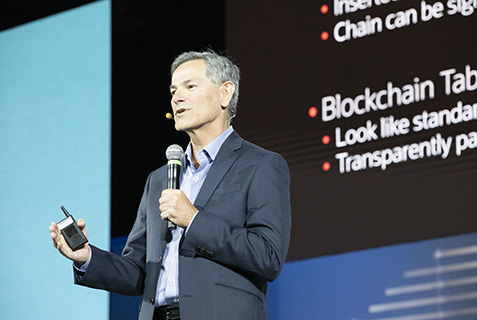4 Technology Shifts That Are Reshaping the Enterprise Database
Blog: Oracle BPM
Shifts happen. And when they hit the enterprise technology world, it sets off a ripple effect where thinkers inside tech companies figure out how and when to react.
One of those thinkers inside Oracle is Juan Loaiza, the company’s executive vice president of mission-critical database technologies, who spoke to a gathering of database experts at Oracle OpenWorld in San Francisco on September 18. “It’s such an interesting time to be in data management,” he said, with tech innovations, regulations, and massive data volumes driving change and opening opportunities.
“Our goal is to look at database trends and take the good ideas and make them better”—and to get rid of the bad ideas, he said. “There’s so much going on in this space. It’s not boring.” Here are four database trends and how Loaiza and his team see them creating new opportunities.
A Self-Driving Database
The machine learning technology that enables self-driving cars—cars that can navigate themselves through a complex or changing environment—is changing perceptions of what’s possible and has many industries looking at “autonomous” possibilities.
Oracle saw the opportunity to bring “self-driving” to its cloud-based database because “we’ve spent so many years developing, automating all the features” that would need to work together in an autonomous database, Loaiza said.
Oracle rebuilt its cloud infrastructure on systems designed to run Oracle Database for top performance and reliability and used machine learning in the infrastructure and database to deliver the first and only self-driving database that deploys, tunes, patches, and secures itself, and scales immediately as demand grows or shrinks. And while the savings in terms of infrastructure and labor are obvious, the deepest value is that it “makes the database more available and a lot more secure,” with autonomous caching, patching, and threat detection, he said. Plus, “you get true elasticity to grow or shrink” your CPUs.
Hyperscale Computing
Hyperscale computing is a computing architecture that can scale up or down quickly to meet increased demand on the system. This architecture innovation was originally driven by internet giants that run distributed sites, such as Facebook, WhatsApp, and Twitter, and has been adopted by large-scale cloud providers like Oracle and Microsoft.
Companies often achieve hyperscale computing using a technology called database sharding, in which they distribute segments of a data set—a shard—across lots of databases on lots of different computers. They often use large numbers of simple databases, called NoSQL databases, to achieve this.
“Sharding is a good idea,” but all those NoSQL databases come with too many restrictions, said Loaiza, such as no schemas, key value access only, and the lack of transaction integrity. Oracle’s goal is to “take a good idea and make it better” by building sharding into its mature SQL database. With sharding in Oracle Database, people who manage massive volumes of data in these hyperscale environments get the scaling and the availability of having lots of independent databases, but get to keep the SQL and the consistent, durable transactions of a mature SQL database. “You get the best of both worlds,” Loaiza said. “We have quite a number of large customers using this technology for their hyperscale environments.”
Blockchain Security
Blockchain got its fame through Bitcoin, but companies are intrigued about using the technology in everyday business uses like tracking goods along a supply chain. Blockchain is a list of records that are cryptographically linked, so it’s hard to make unauthorized changes and the users have a verified history of changes to the record. “Blockchain is just a ledger, but it’s an immutable ledger, which is an interesting idea,” said Loaiza. “I think of it as a nice advancement in computer science and data management, but in many cases more trouble than it’s worth.” For example, a large distributed blockchain platform is more than most enterprise applications need.
Loaiza and his team have worked to understand where blockchain brings value and how to make it much easier for people to use. For example, a blockchain-enabled database underpinning a SaaS supply chain application could make any changes cryptographically immutable.
Oracle is building blockchain into Oracle Database to make it easier for developers to bring the technology into everyday business transactions. “For a database user or an application, blockchain will look like a table. And you’ll be able build these blockchain tables into existing or new applications very simply,” Loaiza said. “You’ll get the value of blockchain without all the other pain that currently comes with it.”
Internet of Things
The Internet of Things means all sorts of sensors and devices can connect, communicate, and share data with each other. The things could be a person’s fitness device or smart thermostat, or a company’s power plant turbine or service vehicle. With all those devices suddenly generating vast quantities of data, companies need to rapidly analyze that IoT data to learn from it and get a competitive edge.
IoT data is moving fast, “so people are coming up with specialized in-memory databases for IoT,” Loaiza said. But those databases are limited in how much data they can hold in memory, and IoT data adds up fast. Oracle has built an IoT streaming feature into Oracle Database that puts IoT data in an in-memory buffer. “And then we have a background process that periodically takes that memory buffer and does a bulk load into the database” for storage and analytics, Loaiza said. And it all happens behind the scenes. “So here again, we’re taking the best parts of this in-memory IoT trend,” he said, then solving problems that the trend brings with it, and making it easier to use.
In the wide-ranging talk, Loaiza also discussed database developments in microservices, JSON, REST services, and cloud services delivered on machines in a customer’s on-premises data centers.
Leave a Comment
You must be logged in to post a comment.








